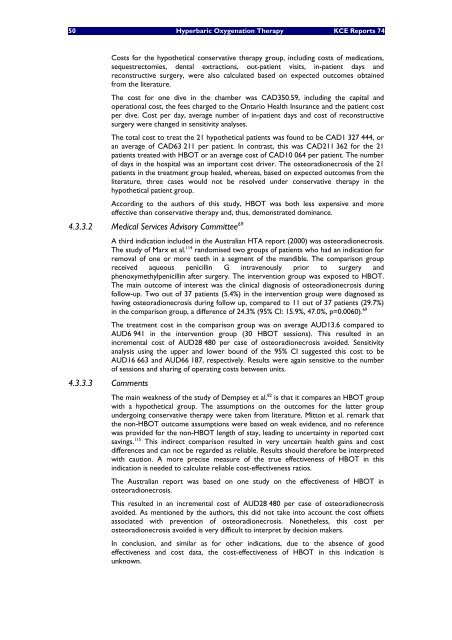Hyperbare Zuurstoftherapie: Rapid Assessment - KCE
Hyperbare Zuurstoftherapie: Rapid Assessment - KCE
Hyperbare Zuurstoftherapie: Rapid Assessment - KCE
Create successful ePaper yourself
Turn your PDF publications into a flip-book with our unique Google optimized e-Paper software.
50 Hyperbaric Oxygenation Therapy <strong>KCE</strong> Reports 74<br />
Costs for the hypothetical conservative therapy group, including costs of medications,<br />
sequestrectomies, dental extractions, out-patient visits, in-patient days and<br />
reconstructive surgery, were also calculated based on expected outcomes obtained<br />
from the literature.<br />
The cost for one dive in the chamber was CAD350.59, including the capital and<br />
operational cost, the fees charged to the Ontario Health Insurance and the patient cost<br />
per dive. Cost per day, average number of in-patient days and cost of reconstructive<br />
surgery were changed in sensitivity analyses.<br />
The total cost to treat the 21 hypothetical patients was found to be CAD1 327 444, or<br />
an average of CAD63 211 per patient. In contrast, this was CAD211 362 for the 21<br />
patients treated with HBOT or an average cost of CAD10 064 per patient. The number<br />
of days in the hospital was an important cost driver. The osteoradionecrosis of the 21<br />
patients in the treatment group healed, whereas, based on expected outcomes from the<br />
literature, three cases would not be resolved under conservative therapy in the<br />
hypothetical patient group.<br />
According to the authors of this study, HBOT was both less expensive and more<br />
effective than conservative therapy and, thus, demonstrated dominance.<br />
4.3.3.2 Medical Services Advisory Committee 69<br />
4.3.3.3 Comments<br />
A third indication included in the Australian HTA report (2000) was osteoradionecrosis.<br />
The study of Marx et al. 114 randomised two groups of patients who had an indication for<br />
removal of one or more teeth in a segment of the mandible. The comparison group<br />
received aqueous penicillin G intravenously prior to surgery and<br />
phenoxymethylpenicillin after surgery. The intervention group was exposed to HBOT.<br />
The main outcome of interest was the clinical diagnosis of osteoradionecrosis during<br />
follow-up. Two out of 37 patients (5.4%) in the intervention group were diagnosed as<br />
having osteoradionecrosis during follow up, compared to 11 out of 37 patients (29.7%)<br />
in the comparison group, a difference of 24.3% (95% CI: 15.9%, 47.0%, p=0.0060). 69<br />
The treatment cost in the comparison group was on average AUD13.6 compared to<br />
AUD6 941 in the intervention group (30 HBOT sessions). This resulted in an<br />
incremental cost of AUD28 480 per case of osteoradionecrosis avoided. Sensitivity<br />
analysis using the upper and lower bound of the 95% CI suggested this cost to be<br />
AUD16 663 and AUD66 187, respectively. Results were again sensitive to the number<br />
of sessions and sharing of operating costs between units.<br />
The main weakness of the study of Dempsey et al. 82 is that it compares an HBOT group<br />
with a hypothetical group. The assumptions on the outcomes for the latter group<br />
undergoing conservative therapy were taken from literature. Mitton et al. remark that<br />
the non-HBOT outcome assumptions were based on weak evidence, and no reference<br />
was provided for the non-HBOT length of stay, leading to uncertainty in reported cost<br />
savings. 115 This indirect comparison resulted in very uncertain health gains and cost<br />
differences and can not be regarded as reliable. Results should therefore be interpreted<br />
with caution. A more precise measure of the true effectiveness of HBOT in this<br />
indication is needed to calculate reliable cost-effectiveness ratios.<br />
The Australian report was based on one study on the effectiveness of HBOT in<br />
osteoradionecrosis.<br />
This resulted in an incremental cost of AUD28 480 per case of osteoradionecrosis<br />
avoided. As mentioned by the authors, this did not take into account the cost offsets<br />
associated with prevention of osteoradionecrosis. Nonetheless, this cost per<br />
osteoradionecrosis avoided is very difficult to interpret by decision makers.<br />
In conclusion, and similar as for other indications, due to the absence of good<br />
effectiveness and cost data, the cost-effectiveness of HBOT in this indication is<br />
unknown.

















